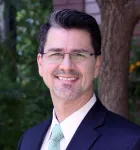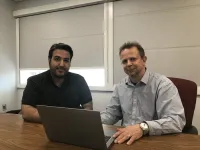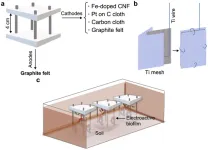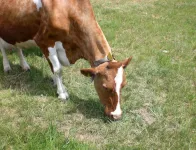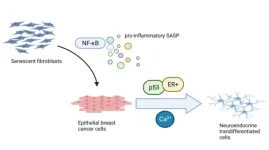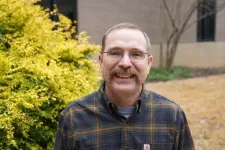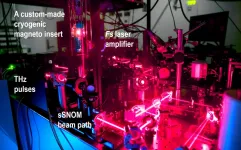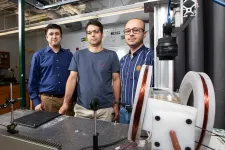(Press-News.org) Misael Cabrera has been selected through a nationwide search as the inaugural director of the School of Mining and Mineral Resources. The school was created in 2021 and is jointly housed in the College of Engineering and the College of Science, with strong partnerships to additional colleges and centers.
“Our role is to deliver talent and technology through research, but also to change the top-of-mind association with mining. We can create real solutions that both industry and our planet need,” said Cabrera.
Cabrera, who began the position in April, most recently served as director of the Arizona Department of Environmental Quality. He graduated from the University of Arizona in 1993 with a civil engineering degree.
“Misael’s appointment is a milestone for the SMMR, and I’m excited to get the ball rolling with the inaugural director,” said David W. Hahn, the Craig M. Berge Dean for the College of Engineering. “It’s fantastic that an engineering Wildcat has the experience to take on this pivotal leadership position.”
College of Science Dean Carmala Garzione is also pleased to welcome Cabrera to the role, she said.
“Misael brings a wealth of knowledge and expertise to the SMMR with decades of experience in the public and private sectors. I look forward to working with Misael to broaden the research and impact of the SMMR and bring together students, professionals and communities to meet the complex challenges toward sustainable mining and mineral resource extraction.”
Linking Assets
The SMMR breaks down disciplinary silos and educates the next generation of mining and mineral resource professionals. It facilitates undergraduate, graduate and professional training in areas including not only engineering and science but also data science, business, social sciences, public health and law.
Cabrera’s initial vision ties together the many layers of mining and minerals: “To be the global destination for educational and research excellence in mining and mineral resources that will catalyze economically, socially and environmentally sustainable mineral resources for generations to come.”
Cabrera plans to engage the SMMR’s technical advisory committee and other key faculty, leadership and industry partners in further developing a vision that’s shared by these stakeholders.
The SMMR works closely with UArizona entities including the Department of Mining and Geological Engineering and the Department of Geosciences, the Lowell Institute for Mineral Resources, Geotechnical Center of Excellence, Mining Safety Center of Excellence, Center for Environmentally Stable Mining and the Global Mining Law Program. In addition, representatives from government agencies and nongovernmental organizations advise on curriculum.
Cabrera says SMMR is poised to solve the planet’s mining and minerals challenges. Aggressive collaboration is required to address the fact that demand for mined materials is surging while the industry faces a labor shortage and lower enrollments in mining education programs, he said. The SMMR and its many partners can deliver what few other schools can by combining assets, he said.
According to Steve Trussell, executive director of the Arizona Rock Products Association and the Arizona Mining Association, the university has made tremendous strides in the mining space.
“Misael has a proven track record in both the public and private sector. He will have no problem bringing the School of Mining and Mineral Resources to the next level,” Trussell added.
In addition to continuing and expanding industry collaboration and research, Cabrera plans to increase school enrollment by recruiting students who are traditionally underrepresented in mining. He also wants to spread the word about the school’s academic minor, available to students from any major. The minor helps students enter the field to fill a variety of positions in a growing industry.
Returning to the Launching Pad
Since Cabrera, who considers UArizona the launching pad for his nearly 30-year career, returned to his alma mater, he’s been “walking around just smiling the whole time.”
“Being able to return and give back is a joy,” he said.
Cabrera was the first in his family to go to a university, and he credits the New Start Summer Program, among other support systems, with helping him graduate.
“New Start – coupled with free tutoring, financial aid, and professors that took an interest in me – all collaborated to help me succeed, and I’m very grateful for that,” he said.
END
UArizona Engineering alum returns to lead School of Mining and Mineral Resources
Misael Cabrera is thrilled to be back at the University of Arizona and ready to collaborate on solutions for industry and the environment
2023-05-12
ELSE PRESS RELEASES FROM THIS DATE:
Researchers track antimicrobial resistance in E. coli isolated from swine
2023-05-12
The spread of drug-resistant microbes has become a global health concern that threatens our ability to treat infections. The widespread use of antimicrobials in livestock, such as swine farms, exacerbates this problem. Therefore, we need surveillance systems to monitor these microbes to support the public health authorities. To this end, researchers have tracked the antimicrobial resistance of Escherichia coli isolated from swine.
Antimicrobials are essential for preventing and treating infections in humans and animals. According to the US Food and Drug Administration, 70% of all antibiotic ...
Carbon-based cathodes impact biofilm composition and performance in soil microbial fuel cells
2023-05-12
In the context of increasing energy demands and environmental concerns, renewable energy solutions are crucial for achieving net-zero emissions by 2050. Microbial electrochemical technologies, such as SMFCs, are cost-effective and environmentally friendly, making them an attractive option for green energy systems. SMFCs utilize endogenous microorganisms present in soil to convert organic matter into electricity, offering a sustainable energy source and a self-powered in situ bioremediation strategy for contaminated soils.
Cathode materials play a significant role in the performance of microbial fuel cells. In this study, researchers compared the performance ...
Healthy teeth thanks to the "washing machine effect”
2023-05-12
Ruminants like cows have developed an unusual way of digesting their food: they ingest plants, give them a rough chewing and then swallow the half-chewed mash before regurgitating it repeatedly and continuing to chew. This has clear advantages, as a research team including the University of Göttingen has shown: the regurgitated mushy food contains much less hard grit, sand and dust than the food that they first ingested. This protects the teeth from being ground down during the chewing process. This ...
The senescence-associated secretory phenotype induces neuroendocrine transdifferentiation
2023-05-12
“We recently unveiled a new interesting role for SASP: its ability to induce neuroendocrine transdifferentiation (NED) in breast cancer epithelial cells [3].”
BUFFALO, NY- May 12, 2023 – A new editorial paper was published in Aging (listed by MEDLINE/PubMed as "Aging (Albany NY)" and "Aging-US" by Web of Science) Volume 15, Issue 8, entitled, “The senescence-associated secretory phenotype induces neuroendocrine transdifferentiation.”
In this editorial, researchers Anda Huna, Nadine Martin and David Bernard from the Université de Lyon discuss the senescence-associated secretory phenotype (SASP). SASP, ...
Steckel selected as a Southern Weed Science Society Fellow
2023-05-12
Larry Steckel, row crop weed specialist and professor in the Department of Plant Sciences at the University of Tennessee Institute of Agriculture, has been named a Fellow of the Southern Weed Science Society (SWSS).
The award was given to honor Steckel’s years of research and contributions to weed prevention in row crop agriculture. Steckel was among only a small group of esteemed researchers to receive the honor, presented to him during the annual meeting of the SWSS.
Steckel says he is proud to be named a Fellow, and that he knows the research and extension work conducted by weed specialists across the ...
Manufacturing and metrology considerations are key when designing with freeform optics
2023-05-12
Manufacturing and metrology considerations are key when designing with freeform optics
Close communication between optics designers and manufacturers can help prevent problems
Québec City, Canada -- Although optical components such as lenses are traditionally spherical in shape, freeform optical components, which have little to no symmetry around the optical axis, are becoming more common. Freeform optical components are attractive because they can be designed to behave in ways traditional optics cannot, offering optical design flexibility ...
Ultralow temperature terahertz microscope capabilities enable better quantum technology
2023-05-12
A team of scientists from the Department of Energy’s Ames National Laboratory have developed a way to collect terahertz imaging data on materials under extreme magnetic and cryogenic conditions. They accomplished their work with a new scanning probe microscope. This microscope was recently developed at Ames Lab. The team used the ultralow temperature terahertz microscope to take measurements on superconductors and topological semimetals. These materials were were exposed to high magnetic fields and temperatures below liquid helium (below 4.2 ...
New study puts a definitive age on Saturn’s rings—they’re really young
2023-05-12
A new study led by physicist Sascha Kempf at the University of Colorado Boulder has delivered the strongest evidence yet that Saturn’s rings are remarkably young—potentially answering a question that has boggled scientists for well over a century.
The research, to be published May 12 in the journal Science Advances, pegs the age of Saturn’s rings at no more than 400 million years old. That makes the rings much younger than Saturn itself, which is about 4.5 billion years old.
“In ...
Researchers identify a brain marker indicating future suicide risk
2023-05-12
FOR IMMEDIATE RELEASE, May 12, 2023
Contact: Gina DiGravio, 617-358-7838, ginad@bu.edu
Researchers Identify a Brain Marker Indicating Future Suicide Risk
Changing the connectivity in this brain circuit with stimulation or pharmacotherapies could represent new treatments to reduce suicide risk.
(Boston)—Identifying people at high risk for suicide is critical for applying lifesaving interventions and treatments. However, it is very difficult to identify who is at greatest risk and only modest improvements has been made in identifying high risk people over the last 50 years. One novel way to identify people at high risk of suicide is by investigating and identifying brain markers.
VA ...
Researchers use 3D models to investigate bacteria movement
2023-05-12
The spiral-shaped bacteria Helicobacter pylori are common and troublesome.
More than 13 percent of Americans have an H. pylori infection, although rates vary with age, race and socioeconomic status. The microorganism uses its corkscrew-like tail to power forward through viscous fluids such as stomach mucus. When it arrives at the epithelium of the stomach wall, it can cause everything from ulcers to cancer.
In a new study published by Physical Review Letters, FAMU-FSU College of Engineering researchers created a 3D model of this bacteria to better understand its movement, hoping to crack the code governing the organism’s motility ...
LAST 30 PRESS RELEASES:
The impact of family dynamics on eating behaviour – how going home for Christmas can change how you eat
Tracing the quick synthesis of an industrially important catalyst
New software sheds light on cancer’s hidden genetic networks
UT Health San Antonio awarded $3 million in CPRIT grants to bolster cancer research and prevention efforts in South Texas
Third symposium spotlights global challenge of new contaminants in China’s fight against pollution
From straw to soil harmony: International team reveals how biochar supercharges carbon-smart farming
Myeloma: How AI is redrawing the map of cancer care
Manhattan E. Charurat, Ph.D., MHS invested as the Homer and Martha Gudelsky Distinguished Professor in Medicine at the University of Maryland School of Medicine
Insilico Medicine’s Pharma.AI Q4 Winter Launch Recap: Revolutionizing drug discovery with cutting-edge AI innovations, accelerating the path to pharmaceutical superintelligence
Nanoplastics have diet-dependent impacts on digestive system health
Brain neuron death occurs throughout life and increases with age, a natural human protein drug may halt neuron death in Alzheimer’s disease
SPIE and CLP announce the recipients of the 2025 Advanced Photonics Young Innovator Award
Lessons from the Caldor Fire’s Christmas Valley ‘Miracle’
Ant societies rose by trading individual protection for collective power
Research reveals how ancient viral DNA shapes early embryonic development
A molecular gatekeeper that controls protein synthesis
New ‘cloaking device’ concept to shield sensitive tech from magnetic fields
Researchers show impact of mountain building and climate change on alpine biodiversity
Study models the transition from Neanderthals to modern humans in Europe
University of Phoenix College of Doctoral Studies releases white paper on AI-driven skilling to reduce burnout and restore worker autonomy
AIs fail at the game of visual “telephone”
The levers for a sustainable food system
Potential changes in US homelessness by ending federal support for housing first programs
Vulnerability of large language models to prompt injection when providing medical advice
Researchers develop new system for high-energy-density, long-life, multi-electron transfer bromine-based flow batteries
Ending federal support for housing first programs could increase U.S. homelessness by 5% in one year, new JAMA study finds
New research uncovers molecular ‘safety switch’ shielding cancers from immune attack
Bacteria resisting viral infection can still sink carbon to ocean floor
Younger biological age may increase depression risk in older women during COVID-19
Bharat Innovates 2026 National Basecamp Showcases India’s Most Promising Deep-Tech Ventures
[Press-News.org] UArizona Engineering alum returns to lead School of Mining and Mineral ResourcesMisael Cabrera is thrilled to be back at the University of Arizona and ready to collaborate on solutions for industry and the environment
